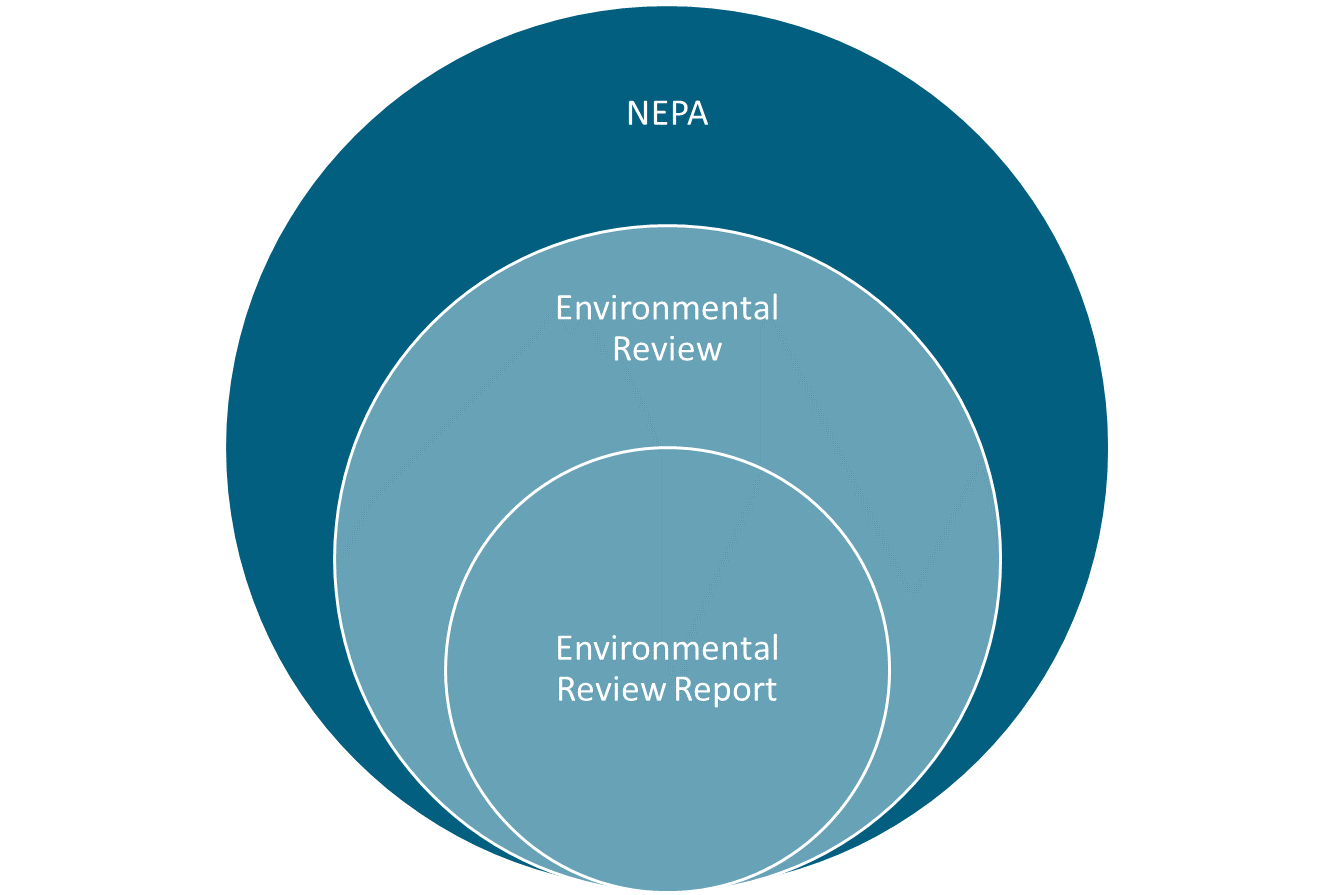Environmental Review

What is NEPA?
Every HUD-assisted project must be in compliance with the National Environmental Policy Act of 1969 (NEPA), HUD’s implementing regulations at 24 CFR Part 58, and other related Federal and State environmental laws. Pursuant to 42 USC § 5304(g)(1) and 24 CFR § 58.4, the State of Nebraska assumes the responsibility for Environmental Reviews, decision-making, and actions that would otherwise be carried out by HUD under NEPA and other statutes.
There are two (2) fundamental aspects of NEPA:
- Public Participation: The public must be informed about the project before it begins.
- Limitation on Activities Before Environmental Clearance: The Responsible Entity (RE) for the project must obtain Environmental Clearance prior to proceeding with the project.
What is Environmental Review?
The purpose of an Environmental Review is to analyze the effect a proposed project will have on the people and the natural environment within a designated project area. The environmental review process is required for all HUD-assisted projects, including those funded with CDBG-DR funds, to ensure that the proposed project meets federal, state, and local environmental standards. The Environmental Review must occur before any CDBG-DR funds are spent.

Want to Learn More?
The State of Nebraska’s Disaster Recovery Action Plan further articulates requirements and programmatic structures that apply to all CDBG-DR programs. For more information on the Environmental Review process, see HUD resources:
- Overview: Environmental Review
- Training: Basics of a Part 58 Environmental Review for HUD-Assisted Projects Webinar
- Orientation to Environmental Reviews
For more information on compliance with federal requirements, see:
- Environmental Review Procedures for Entities Assuming HUD Environmental Responsibilities (24 CFR Part 58);
- Federal Register Notice from February 9, 2018 (83 FR 5844);
- Federal Register Notice from January 27, 2020 (85 FR 4681); and
- Community Development Block Grants (24 CFR Part 570).
Roles and Responsibilities
Nebraska Department of Economic and Development (DED)
DED is responsible for ensuring that the Environmental Review is completed for each project. The Risk Awareness Planning Program and the Housing Resiliency Planning Program are exempt from the NEPA Environmental Review.
Subrecipients and Successful Applicants
To meet Federal requirements, Subrecipients or Successful Applicants must complete (or work with DED to complete) the Environmental Review process before DED obligates funds to the project.
- A qualified Responsible Entity (RE) responsible for conducting an Environmental Review must be identified for each project;
- The RE must prepare and maintain a written record of Environmental Review undertaken for each project to be assisted with CDBG-DR funds; and
- Some Subrecipients, such as non-profit organizations, and other Successful Applicants may not qualify as a RE but can partner with a local government organization that can perform the RE role.
Infrastructure Match Program
NEPA Applicability
Environmental review under NEPA to be performed by FEMA, adopted by Subrecipients and approved by DED. These may be completed as an Environmental Assessment (EA) or Environmental Impact Statement (EIS) for individual construction projects depending on the potential for significant environmental impacts.
DED and its consultant will review and approve environmental documents per HUD NEPA guidelines.
NEPA review must be completed prior to Federal funds being committed or dispersed.
Level of Environmental Review
During the detailed eligibility review process, DED will determine the level of environmental review required and completed for each FEMA PA Match and FEMA HMGP Match project, based on information provided by Applicants in the pre-application form.
If FEMA has already completed an Environmental Review for a FEMA PA Match and FEMA HMGP Match project, a Subrecipient is the RE and is therefore responsible for completing the following actions to “adopt” FEMA or another Federal agency’s Environmental Review:
- Review the Environmental Review package and confirm that the project actions covered by the original Environmental Review document and the proposed actions are the same;
- Confirm documents are signed by the respective agencies;
- Confirm the original Environmental Review document is not more than one (1) year old (If it is, that document should be updated);
- Review FEMA’s Environmental and Historical Preservation (EHP) documents, if applicable;
- DED issues the Environmental Clearance Letter that signifies the RE has met all of the other specified requirements, once validated; and
- Submit a completed Request for Release of Funds (RROF) to DED along with the following document:
- If the original Environmental Review document was completed by the same RE and meets the above requirements (e.g., is not more than 1 year old), then Subrecipients complete the Finding of CENST Activity Form on DED’s website.
- If the original Environmental Review document was completed by a different RE, but still meets the above requirements (e.g., is not more than 1 year old), then the Subrecipient will complete an adoption memo to notify the original RE that their Environmental Review is being adopted.
If a different Federal agency completed the Environmental Review, and it meets the above requirements (e.g., is not more than one (1) year old), then the Subrecipient will complete an adoption memo to notify the original RE that their Environmental Review is being adopted. If the original Environmental Review does not meet all of HUD’s standards (e.g., Proximity to Airport Runway Protection Zones), then the document must be updated.
Want to Learn More?
For more information on the adoption of Environmental Review documents for NEPA compliance, see DED’s Chapter 9: Environmental Review of the CDBG-DR Policy Manual.
Affordable Housing Construction Programs
The award Subrecipient will act as the RE, responsible for conducting environmental reviews and maintaining the ERR. Non-profit organizations and Successful Applicants that are awarded funding but do not qualify as a RE will need to partner with a local government organization that can act as the RE. All housing construction projects will be subject to NEPA review pursuant to
24 CFR § 58.5.
Environmental review under NEPA is the responsibility of the Subrecipient (acting as RE). Some Subrecipients, such as non-profit organizations, and other Successful Applicants may not qualify as a RE but can partner with a local government organization that can perform the RE role. The NEPA environmental review will be performed by Subrecipients or others qualified to perform the RE role and approved by DED. The NEPA level of review will be determined by the project details and potential for significant environmental impacts.
DED and its consultant will review and approve environmental documents per HUD NEPA guidelines prior to submittal to DED’s Certifying Officer.
NEPA review must be completed prior to Federal funds being committed or dispersed.
Planning Programs
The Risk Awareness Planning Program and the Housing Resilience Planning Program are exempt activities per 24 CFR § 58.34(a)(1) and excluded from NEPA review but subject to applicable requirements of 24 CFR § 58.6. 24 CFR § 58.6, including Flood Insurance, Flood Disaster Protection Act of 1973, National Flood Insurance Reform Act of 1994, Coastal Barrier Resources Act, and runway clear zone requirements apply to all projects, regardless of the level of review.
Frequently Asked Questions
Q: Do programs require environment permitting in addition to the environmental review?
A: Additional permits may apply depending on the location and scope of a specific project. Permitting requirements for individual projects may include:
- National Pollutant Discharge Elimination System (NPDES) construction permits for projects greater than 1 acre in area through the Nebraska Department of Environment and Energy (DEE) (US Clean Water Act [CWA] Section 402);
- CWA Section 401/404 permitting through the US Army Corps of Engineers and DEE (including potential wetland delineation) based on proximity to water;
- Endangered Species Act consultation with US Fish and Wildlife Service or Nebraska Game and Parks Commission (including potential biological surveys);
- National Historic Preservation Act (NHPA) consultation with State Historic Preservation Office (including potential cultural resources surveys);
- Native American Tribal consultation under the NHPA;
- Clean Air Act air quality permitting through the DEE. Local air permitting for construction equipment may be required;
- A Phase I Environmental Site Assessment (ESA) may be warranted to assess potential impacts from hazardous materials. Lead-based paint and asbestos surveys may also be warranted;
- HUD Noise Abatement and Control checklist and compliance with local noise ordinances;
- Consultation with the US Department of Agriculture under the Farmlands Protection Act; and
- Consultation with the US Environmental Protection Agency (EPA) under the Safe Drinking Water Act.
Contact Information
Questions and comments regarding CDBG-DR programs should be directed to the State of Nebraska’s Department of Economic Development (DED) via email at ded.cdbgdr@nebraska.gov or by calling (800)-426-6505.

